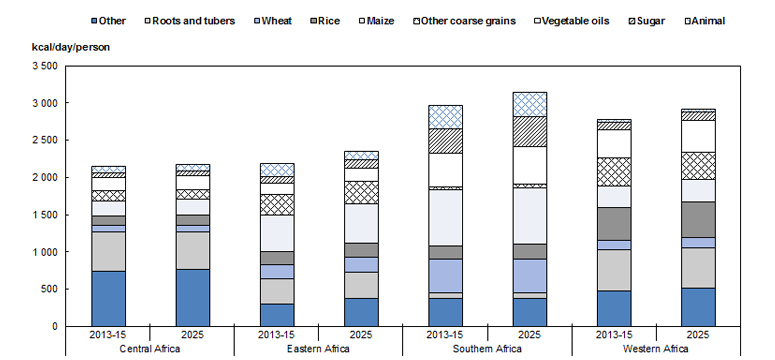Special feature: Sub-Saharan Africa
- In Sub-Saharan Africa, agriculture continues to play an important role in development
- Agricultural growth increasingly driven by productivity improvements
- Increasing imports for many basic food commodities
- Cash crops offer alternative sources of income
- Stable policies combined with investments could improve the future of agriculture in the region
There are more than 950 million people in the Sub-Saharan Africa (SSA) region, approximately 13% of the global population. Despite ongoing transformation of the region’s economies, agriculture remains a crucial sector, providing livelihoods for millions of people. Regional differences in the structure and development stage of agriculture reflect the vast agro-ecological, economic, political and cultural differences across the continent. Undernourishment has been a long-standing challenge, with uneven progress toward food security across the region.
Caloric intake by commodity group in Sub-Saharan Africa

Source: OECD/FAO (2016), "OECD-FAO Agricultural Outlook", OECD Agriculture statistics (database),
http://dx.doi.org/10.1787/888933381429.
Development of the region's agricultural sector is being shaped by rapid population growth, urbanisation and rural diversification, an associated structural transformation from farm to non-farm employment, the rise of a middle class, and increasing interest (both domestically and globally) in the continent’s farmland. Total agricultural production is projected to expand by 2.6% p.a. In contrast with past production increases, which overall were driven by area expansion, an increasing share of future production growth will come from improved productivity. Inclusive development will be needed that improves the productivity of small-scale, resource poor farmer, while creating broader rural development opportunities.
Assuming continued rapid population growth across the region, complemented by rising incomes and continuation of current policies and market structures, the production of food crops in many countries is projected to grow more slowly than demand. Sub-Saharan Africa’s net imports of food commodities are anticipated to grow over the next decade, although productivity enhancing investments would mitigate this trend.
Many countries are competitive producers and regular exporters of fruit and beverage crops, which contribute to foreign currency reserves. Such products may offer farmers alternative opportunities to traditional food crops. They may also be a potentially important source of employment for the continent’s young population. With a limited number of food exporters, and a large number of net importers, open regional trade will be central to food security.
While the outlook for agriculture in Sub-Saharan Africa is broadly positive, it could be much improved by more stable policies across the region, by strategic public and private investments, notably in infrastructure, and by suitably adapted research and extension. Such investments could improve access to markets, reduce post-harvest losses, and make needed inputs more widely available.

